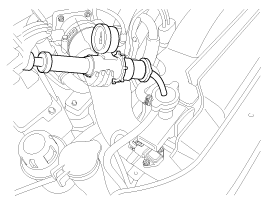Apply the pressure of 137.29kpa (1.4kg/cm², 19.91psi) to the radiator with the tester.

Wait until engine is cool, then carefully remove the radiator cap and fill the radiator with engine coolant, then install a pressure tester on it.
Warm up the engine.
Apply the pressure of 137.29kpa (1.4kg/cm², 19.91psi) to the radiator with the tester.

Inspect for engine coolant leaks and a drop in pressure.
If the pressure drops, check hoses, the radiator and the water pump for leakage. If there is no leakage, inspect the heater core, the cylinder block and the cylinder head.
Remove the tester and reinstall the radiator cap.
Check for engine oil in coolant and/or coolant in engine oil.
The engine coolant level should be between the 'L' and 'F' lines, when the engine is cold. If low, check for leaks and add quality-qualified engine coolant from HMC. If you can't get any quality-qualified coolant, add similar high quality mono-ethylene glycol based non-silicate, non-amine, non-nitrite, and non-borate coolant or equivalent to 'F' line.
Wait until engine is cool, and then carefully remove the radiator cap.
Check if there is any excessive deposits of rust or scale around the radiator cap.
If excessive dirty, clean the cooling system and replace coolant.
Reinstall the radiator cap.